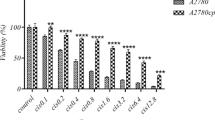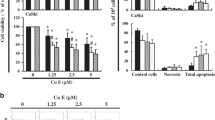Abstract
Sulforaphene from cruciferous vegetable has shown to modulate various signaling pathways of apoptosis. But it has not yet been studied extensively for the cervical cancer treatment. Previous studies show the promising role of photodynamic therapy for cervical cancer. Here, we confirm that sulforaphene can synergistically enhance the efficacy of photodynamic therapy. Human cervical cancer cells HeLa were treated with a very low dose of sulforaphene (2.0 μg/ml) and photodynamic therapy with radachlorin (0.5 μg/ml) at a fluence of 27 J/cm2 (30 milliwatts/cm2, λmax ∼ 670 ± 3 nm). The combination treatment showed a synergistic effect to induce apoptosis. The mitochondrial apoptotic pathway was activated via caspase 3 and caspase 9. On the other hand, caspase 12 and C/EBP homologous protein (CHOP) were expressed that indicated endoplasmic reticulum stress. This combination treatment also activated death receptor pathway via activation of caspase 8 and inhibited cell proliferation via down-regulation of EGFR. Thus, several apoptotic pathways were simultaneously activated in this combination treatment which results in a synergistic efficacy of sulforaphene with photodynamic therapy. Therefore, this study could be useful in the improvement of therapies for human cervical and other types of cancers.






Similar content being viewed by others

References
Angelino D, Jeffery E (2014) Glucosinolate hydrolysis and bioavailability of resulting isothiocyanates: focus on glucoraphanin. J Funct Foods 7:67–76
Deng Q, Zinoviadou KG, Galanakis CM, Orlien V, Grimi N, Vorobiev E, Lebovka N, Barba FJ (2014) The effects of conventional and non-conventional processing on glucosinolates and its derived forms, isothiocyanates: extraction, degradation, and applications. Food Engineering Reviews: 1-25
Kadir NHA, Rossiter JT, Gooderham N (2014) Glucosinolate hydrolysis products of cruciferous vegetables inhibit cytochrome P450 1A activity and mediate oxidative stress. Toxicol Lett 229:S88–S89
Conaway C, Yang Y, Chung F (2002) Isothiocyanates as cancer chemopreventive agents: their biological activities and metabolism in rodents and humans. Curr Drug Metab 3(3):233–255
Mondal A, Biswas R, Rhee YH, Kim J, Ahn JC (2015) Sulforaphene promotes Bax/Bcl2, MAPK-dependent human gastric cancer AGS cells apoptosis and inhibits migration via EGFR, p-ERK1/2 down-regulation. General physiology and biophysics. doi:10.4149/gpb_2015033
Dolmans DE, Fukumura D, Jain RK (2003) Photodynamic therapy for cancer. Nat Rev Cancer 3(5):380–387
Biswas R, Moon JH, Ahn JC (2014) Chlorin e6 derivative radachlorin mainly accumulates in mitochondria, lysosome and endoplasmic reticulum and shows high affinity toward tumors in nude mice in photodynamic therapy. Photochem Photobiol 90(5):1108–1118. doi:10.1111/php.12273
Ahn JC, Biswas R, Chung PS (2012) Combination with genistein enhances the efficacy of photodynamic therapy against human anaplastic thyroid cancer cells. Lasers Surg Med 44(10):840–849. doi:10.1002/lsm.22095
Ahn JC, Biswas R, Chung PS (2013) Synergistic effect of radachlorin mediated photodynamic therapy on propolis induced apoptosis in AMC-HN-4 cell lines via caspase dependent pathway. Photodiagnosis Photodyn Ther 10(3):236–243. doi:10.1016/j.pdpdt.2013.01.005
Hwang H, Biswas R, Chung PS, Ahn JC (2013) Modulation of EGFR and ROS induced cytochrome c release by combination of photodynamic therapy and carboplatin in human cultured head and neck cancer cells and tumor xenograft in nude mice. J Photochem Photobiol B Biol 128:70–77. doi:10.1016/j.jphotobiol.2013.08.001
Biswas R, Ahn JC, Kim JS (2015) Sulforaphene synergistically sensitizes cisplatin via enhanced mitochondrial dysfunction and PI3K/PTEN modulation in ovarian cancer cells. Anticancer Res 35(7):3901–3908
Biswas R, Mondal A, Ahn JC (2015) Deregulation of EGFR/PI3K and activation of PTEN by photodynamic therapy combined with carboplatin in human anaplastic thyroid cancer cells and xenograft tumors in nude mice. J Photochem Photobiol B Biol 148:118–127. doi:10.1016/j.jphotobiol.2015.03.024
Biswas R, Chung P-S, Moon J, Lee S-H, Ahn J-C (2014) Carboplatin synergistically triggers the efficacy of photodynamic therapy via caspase 3-, 8-, and 12-dependent pathways in human anaplastic thyroid cancer cells. Lasers Med Sci 29(3):995–1007. doi:10.1007/s10103-013-1452-9
Chou TC (2010) Drug combination studies and their synergy quantification using the Chou-Talalay method. Cancer Res 70(2):440–446. doi:10.1158/0008-5472.can-09-1947
HemaIswarya S, Doble M (2006) Potential synergism of natural products in the treatment of cancer. Phytother Res 20(4):239–249. doi:10.1002/ptr.1841
Liu RH (2004) Potential synergy of phytochemicals in cancer prevention: mechanism of action. J Nutr 134(12):3479S–3485S
Ahn J-C, Biswas R, Chung P-S (2013) Synergistic effect of radachlorin mediated photodynamic therapy on propolis induced apoptosis in AMC-HN-4 cell lines via caspase dependent pathway. Photodiagn Photodyn Ther 10(3):236–243
Byun S, Shin SH, Park J, Lim S, Lee E, Lee C, Sung D, Farrand L, Lee SR, Kim KH, Dong Z, Lee SW, Lee KW (2016) Sulforaphene suppresses growth of colon cancer-derived tumors via induction of glutathione depletion and microtubule depolymerization. Mol Nutr Food Res 60(5):1068–1078. doi:10.1002/mnfr.201501011
Liu K, Shi Y, Guo X, Wang S, Ouyang Y, Hao M, Liu D, Qiao L, Li N, Zheng J, Chen D (2014) CHOP mediates ASPP2-induced autophagic apoptosis in hepatoma cells by releasing Beclin-1 from Bcl-2 and inducing nuclear translocation of Bcl-2. Cell Death Dis 5:e1323. doi:10.1038/cddis.2014.276
Jo GH, Kim GY, Kim WJ, Park KY, Choi YH (2014) Sulforaphane induces apoptosis in T24 human urinary bladder cancer cells through a reactive oxygen species-mediated mitochondrial pathway: the involvement of endoplasmic reticulum stress and the Nrf2 signaling pathway. Int J Oncol 45(4):1497–1506. doi:10.3892/ijo.2014.2536
Oda K, Matsuoka Y, Funahashi A, Kitano H (2005) A comprehensive pathway map of epidermal growth factor receptor signaling. Molecular Systems Biology 1:2005.0010-2005.0010. doi:10.1038/msb4100014
Lo HW, Hung MC (2006) Nuclear EGFR signalling network in cancers: linking EGFR pathway to cell cycle progression, nitric oxide pathway and patient survival. Br J Cancer 94(2):184–188
Acknowledgments
The present research was conducted by the research fund of Dankook University in 2015.
Author information
Authors and Affiliations
Corresponding author
Rights and permissions
About this article
Cite this article
Biswas, R., Mondal, A., Chatterjee, S. et al. Evaluation of synergistic effects of sulforaphene with photodynamic therapy in human cervical cancer cell line. Lasers Med Sci 31, 1675–1682 (2016). https://doi.org/10.1007/s10103-016-2037-1
Received:
Accepted:
Published:
Issue Date:
DOI: https://doi.org/10.1007/s10103-016-2037-1



